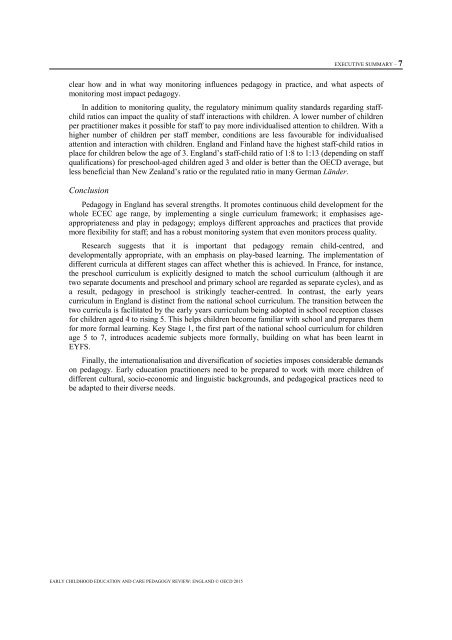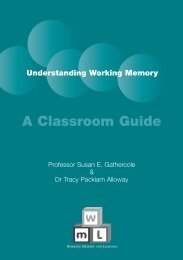6 – EXECUTIVE SUMMARY• Secondly, play-based learning, for example through the use of puzzles <strong>and</strong> constructional materials,is found to be a highly effective method of enhancing child development. Within play, the waysensitive adults help children reflect on situations, through scaffolding, for example, is important.Scaffolding-focused learning environments, where the practitioner attempts to help children onlywith tasks that are just beyond their current capability, demonstrated greater overall positive effectson children’s development than teacher-directed <strong>and</strong> child-centred environments.• This suggests that, thirdly, <strong>pedagogy</strong> should neither be too staff-directed or staff-focused, with ahigh share of staff-initiated activities, or too child-centred, where children decide on the activities.While studies on staff-directed approaches have revealed some advantages, such as betterachievement in letters <strong>and</strong> reading, this approach negatively affects children’s motivation tolearn. In France, it was found that highly teacher-directed pedagogical practices were less effective.In Germany, for example, a child-centred <strong>pedagogy</strong>, in combination with specific teacher-managedactivities <strong>and</strong> a high level of assistance, was found to help develop academic skills such asnumeracy <strong>and</strong> literacy, <strong>and</strong> children also demonstrated higher levels of well-being <strong>and</strong> motivation tolearn. Research in the United States also found that mixed teacher- <strong>and</strong> child-managed activities areassociated with alphabet <strong>and</strong> letter–word growth, <strong>and</strong> purely child-managed experiences, includingplay, were associated with vocabulary growth.Engl<strong>and</strong> is one of few governments that have commissioned research in its owncountry on which pedagogical practices are found to benefit child development.Research affects <strong>pedagogy</strong> <strong>and</strong> pedagogical practices, because its findings can inform policymakers <strong>and</strong> practitioners on best practices <strong>and</strong> on what works best in enhancing staff performance,process quality <strong>and</strong> child development. Research on <strong>pedagogy</strong> <strong>and</strong> practices usually focuses onparticular programmes, <strong>and</strong> only limited information is available on specific approaches, regionsor ECEC settings. Engl<strong>and</strong> is one of the few governments to have based its national pedagogicalguidance for staff on practices that have been researched within its own borders. New Zeal<strong>and</strong> hascarried out something similar, although its best practices are listed as examples online rather thanintegrated into staff guidance. Many other countries do not conduct any research on pedagogicaleffectiveness.Does the regulation or monitoring of ECEC quality influence <strong>pedagogy</strong>?While all countries <strong>review</strong>ed in this study monitor quality in ECEC, only Engl<strong>and</strong>, Germany<strong>and</strong> New Zeal<strong>and</strong> monitor process quality or pedagogical quality in particular. In Engl<strong>and</strong>, thoughpedagogical approaches <strong>and</strong> practices are not specified in the curriculum framework, pedagogicalpractice is assessed by inspectors regarding its impact upon children’s learning, development <strong>and</strong>well-being. The scope of monitoring process quality in New Zeal<strong>and</strong> <strong>and</strong> several Länder inGermany is broader than in Engl<strong>and</strong>, including aspects such as the overall quality ofteaching/instruction/caring; relationships <strong>and</strong> interactions between staff <strong>and</strong> children;collaborations between staff <strong>and</strong> parents, management, or between colleagues; <strong>pedagogy</strong>; <strong>and</strong>implementation of curriculum by staff.Engl<strong>and</strong>, like New Zeal<strong>and</strong> <strong>and</strong> Länder in Germany, monitors process qualityby observing <strong>and</strong> assessing staff practices <strong>and</strong> interactions with children.Pedagogical practices are influenced by organisations that monitor settings’ results <strong>and</strong>practices. Indeed, if staff are assessed on their actual interactions <strong>and</strong> activities with children, <strong>and</strong>receive feedback, they will to some extent reflect on this <strong>and</strong> can improve their practices <strong>and</strong>interactions. However, given the current limitations of the data <strong>and</strong> information available, it is notEARLY CHILDHOOD EDUCATION AND CARE PEDAGOGY REVIEW: ENGLAND © OECD 2015
EXECUTIVE SUMMARY – 7clear how <strong>and</strong> in what way monitoring influences <strong>pedagogy</strong> in practice, <strong>and</strong> what aspects ofmonitoring most impact <strong>pedagogy</strong>.In addition to monitoring quality, the regulatory minimum quality st<strong>and</strong>ards regarding staffchildratios can impact the quality of staff interactions with children. A lower number of childrenper practitioner makes it possible for staff to pay more individualised attention to children. With ahigher number of children per staff member, conditions are less favourable for individualisedattention <strong>and</strong> interaction with children. Engl<strong>and</strong> <strong>and</strong> Finl<strong>and</strong> have the highest staff-child ratios inplace for children below the age of 3. Engl<strong>and</strong>’s staff-child ratio of 1:8 to 1:13 (depending on staffqualifications) for preschool-aged children aged 3 <strong>and</strong> older is better than the OECD average, butless beneficial than New Zeal<strong>and</strong>’s ratio or the regulated ratio in many German Länder.ConclusionPedagogy in Engl<strong>and</strong> has several strengths. It promotes continuous child development for thewhole ECEC age range, by implementing a single curriculum framework; it emphasises ageappropriateness<strong>and</strong> play in <strong>pedagogy</strong>; employs different approaches <strong>and</strong> practices that providemore flexibility for staff; <strong>and</strong> has a robust monitoring system that even monitors process quality.Research suggests that it is important that <strong>pedagogy</strong> remain child-centred, <strong>and</strong>developmentally appropriate, with an emphasis on play-based learning. The implementation ofdifferent curricula at different stages can affect whether this is achieved. In France, for instance,the preschool curriculum is explicitly designed to match the school curriculum (although it aretwo separate documents <strong>and</strong> preschool <strong>and</strong> primary school are regarded as separate cycles), <strong>and</strong> asa result, <strong>pedagogy</strong> in preschool is strikingly teacher-centred. In contrast, the <strong>early</strong> yearscurriculum in Engl<strong>and</strong> is distinct from the national school curriculum. The transition between thetwo curricula is facilitated by the <strong>early</strong> years curriculum being adopted in school reception classesfor children aged 4 to rising 5. This helps children become familiar with school <strong>and</strong> prepares themfor more formal learning. Key Stage 1, the first part of the national school curriculum for childrenage 5 to 7, introduces academic subjects more formally, building on what has been learnt inEYFS.Finally, the internationalisation <strong>and</strong> diversification of societies imposes considerable dem<strong>and</strong>son <strong>pedagogy</strong>. Early <strong>education</strong> practitioners need to be prepared to work with more children ofdifferent cultural, socio-economic <strong>and</strong> linguistic backgrounds, <strong>and</strong> pedagogical practices need tobe adapted to their diverse needs.EARLY CHILDHOOD EDUCATION AND CARE PEDAGOGY REVIEW: ENGLAND © OECD 2015



